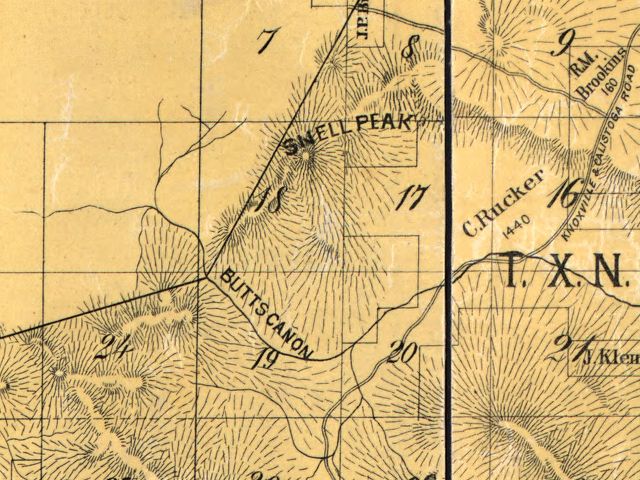Napa County, People
You Can’t Get There from Here…
by Marie Bowen
“The Valleys of Napa County,” a May 23, 1998, Napa Valley Register supplement, celebrates the 23 valleys within our county. Eight of the 23, as many of us know, were named for easily identifiable pioneer individuals or families: Berryessa, Brown, Capell, Chiles, Conn, Gordon, Pope, and Wooden. Two more of the valleys, Snell and Lovall, by virtue of their names, seem also to be associated with early settlers. These people were not identified in the 1998 supplement and for good reason.
Snell and Lovall lie at opposite ends of Napa County. Snell is five miles north of Angwin and includes Snell Peak, at or on the Napa and Lake Counties boundary line. Lovall is found within the Huichica Rancho west of Carneros and lying partly in Sonoma County. Looking at the valleys’ respective locations, each of them straddling a county boundary line, I wondered if the answers lay across those lines. Learning from local planning staff that the names were also a mystery to them, I decided to search records for Lake and Sonoma Counties.
I began with Snell. Prior to the 1861 creation of Lake County, Napa County stretched northerly, including Middletown and Lower Lake and even portions of Clear Lake itself. East of Middletown and part of Napa County at that time lay Guenoc Rancho, its southernmost point almost touching what is now the Lake and Napa boundary. Rancho residents included people whose names remained part of Napa County long after 1861, including A. H. Butts, John Cobb, and A. A. Ritchie, and living near Mr. Butts back in 1857 were two brothers from Germany, George and Hiram Snell, who were still in the area as of the 1860 Federal Census. They are the only Snells identified in records of this area and time period. Their trail runs cold after 1860, however a website on South Lake County history presumes, as I do, that the brothers “apparently became the namesakes of a small valley in Butts Canyon.” What these two men did to cause a valley and a mountain to be named for them, I do not know. In fact, I have no idea how the surveyors themselves, as they prepared the 1876 Official Map of Napa County, knew that Snell Peak should be identified as Snell Peak on their map. That is another research topic.
Finding no further telling, or contradicting, facts about Snell, I moved on to Lovall. The aforementioned Register supplement includes an article entitled, “You Can’t Get There from Here: Lovall Valley.” It explains that the valley is extremely isolated, accessible only from its Sonoma County side (just east of the city of Sonoma), and that no one, either in Napa or Sonoma, “seems to know…who inspired the valley’s name.” Still, I kept looking.
The website for Grieve Family Vineyard, presently in Lovall Valley, provides this helpful geographic description: “Lovall Valley occupies a unique position geographically, climatically, viticulturally and historically. Located between the towns of Napa and Sonoma, straddling the county line just north of Carneros, Lovall Valley is only 1.25 miles long and less than a half-mile wide and is the last pocket before the Mayacamas Mountains give way to Carneros and the San Pablo Bay to the south.” Sadly and unexpectedly, the website also describes what is called the Lovall Valley Massacre of 1863, in which 100 Native American residents were killed by Sonoma Barracks cavalry. This tragedy also is mentioned in Jeff Dwyer’s Ghost Hunter’s Guide to California’s Wine Country, but apparently remains relatively unknown otherwise. Dwyer posits that skeptics find it difficult to believe this atrocity occurred. I feel apologetic that I must stay with the purpose of my story, so suffice to say I learned Lovall Valley existed as early as 1863.
I found no Napa County residents named Lovall in the Huichica area circa 1860. Stuart Duhig’s Huichica, mentions both the valley and Lovall Falls within it, but, again, no settlers named Lovall. In Sonoma County records I found the marriage of Drury G. Loveall (sometimes spelled Lovall in other records) and Nancy Gannon. Drury was both farmer and Baptist minister, and by 1860 he and his family were in Oregon, although they later lived in Mendocino County. Also marrying in Sonoma in 1853 were Frances Loveall (Lovall on her burial record) and John Huffman. Frances and Drury appear not to be siblings, but by 1860 Frances and John also relocated to Oregon, so it’s possible they were related.
Additional fruitless searching brought me to the proverbial blank wall. There is an answer to this somewhere – the valley didn’t name itself – but for the present, as the Lovall Valley article says, “You Can’t Get There from Here…”
Reference List
Napa Valley Register. ‘The Valleys of Napa County.’ May 23, 1998
Cahill, Kim Nicholas. ‘From Turkey Ranch to Wealthy Retreat: The Making of Lovall Valley, California.’ 22 April 2002. Found at williamcronon.net.
Dwyer, Jeff. GHOST HUNTER’S GUIDE TO CALIFORNIA WINE COUNTRY. Pelican Publishing, 2008
Heintz, William. A BRIEF HISTORY OF GRAPE GROWING AND WINE MAKING IN THE CARNEROS REGION OF NAPA VALLEY, CALIFORNIA. October 1980.
Napa Valley Register. ‘The Valleys of Napa County.’ May 23, 1998
Scavone, Kathleen. ‘Lake County Time Capsule: The Historic Stone House.’ Lake County News, February 1, 2015
Sonoma County Marriage Records, 1844-1860. Ancestry.com
Wilson Daniels. ‘Grieve Family Winery/Lovall Valley.’ 2014. Found at wilsondaniels.com.


